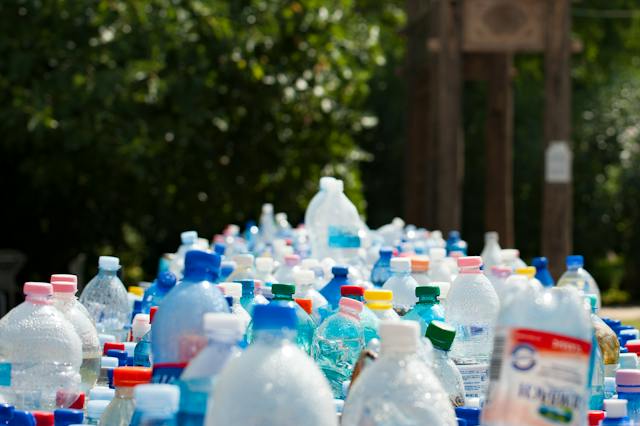
Are any plastics biodegradable? Some are, but most aren’t. It depends on what they are made from and how they are made.
Most natural materials biodegrade once they are dead. Inside the cells of the dead material are polymers, which are chains of small molecules strung together. Bacteria and other organisms break down the cell structures of the material and break up the polymers by using enzymes that eat through the polymer connections. When the connections are gone, the nutrients, minerals, water, carbon dioxide, and compounds that the material was made of are released. These compounds are absorbed by the bacteria and organisms, or they are released into the soil where other creatures or organisms can make use of them. After a certain length of time, all trace of the original material has gone. When something dies, it becomes part of the chain of life again. This doesn’t happen with plastics.
Why aren’t most plastics biodegradable? Generally, plastics are made from oil, which contains a lot of propylene. This propylene can be removed when the oil is refined and a catalyst is added to it to make the molecules of propylene join together and form long polymers. The bonds between the propylene molecules are very strong, which is what gives plastic its strength. When plastic is thrown away, you might think the polymer bonds would be broken down by the enzymes that break down the polymers in so many other things, but that doesn’t happen. The enzymes in the microorganisms don’t recognize the propylene polymers because they are not something that appears naturally in nature. They don’t attack the polymers and don’t break them down. The bonds between the molecules do eventually break, but that can take hundreds of thousands of years. This is why plastics don’t biodegrade.
That is not to say that plastic doesn’t degrade. It does break down, which is another of the problems with plastic. UV light is able to break some of the bonds that hold the propylene polymers together. Friction is also able to do it. Oxygen exposure can do it as well. The problem is, they can’t break all of the polymers and the broken down plastic ends up as microplastics and a large majority of them end up in the sea.
Are there any plastics that do biodegrade? Yes. There are two types of plastic currently being manufactured that biodegrade. The first type are polylactic acid (PLA). They are made from the sugars found in corn starch or sugarcane. Corn kernels are broken down into starch, protein, and fiber, by submerging them in sulfur dioxide and hot water. The corn oil is separated. The starch has chains of carbon molecules and citric acid is added to make the chains stick together and form the long polymers that are in plastics. PLA can be used in place of a variety of plastics. PLA biodegrades, at least it can be broken down. If it is heated to a high temperature or exposed to high humidity for a long period of time, it will break down into carbon dioxide and water.
PLA is better for the environment than regular plastic, but unless it can be broken down in a special treatment facility, it will take a decade or more to break down. This is still better than plastic. The main problem with PLA is that the corn or sugar cane that it is made from are not good for the environment. This is due to the heavy use of pesticides, water, pollution produced, and the chemical processing needed. It will help with the microplastic problem, but it is not a sollution.
The second type of biodegradable plastics are polyhydroxyalkanoates (PHA). They are made by microorganisms. The microorganisms are fed high levels of carbon along with the other minerals then need. Then, they are deprived of the other minerals in a feast-fast cycle. When they are forced to fast, they store the carbon in granular form. These granules have the same chemical structure as plastic, but they are naturally made and will biodegrade. They are a potential replacement for plastics, but they take a long time to make and they are very expensive. Research is ongoing into how this can be scaled up and made more affordable.
As the majority of the plastic we use is not biodegradable, a lot of people are looking into plastic replacements. Some scientists are looking into how to use wastewater and human waste as a source of fatty acids that they can use to make PHA. There is an endless source of human waste and it could be a way of making it more cheaply. A Japanese company is making plastic replacements from agar, which is a gelatin substance made from red seaweed. They melt it, pour it into a mold, freeze it, dry it, and it holds the shape of the mold. It can be used for packaging and potentially replace plastics in other ways as well. And this is what I learned today.
Photo by mali maeder: https://www.pexels.com/photo/assorted-plastic-bottles-802221/
Sources
https://www.good.is/articles/agar-plasticity-amam-araki-maetani-muraoka-packaging
https://news.osu.edu/why-isnt-plastic-biodegradable/
https://en.wikipedia.org/wiki/Biodegradation
https://www.colorado.edu/ecenter/2021/03/10/bioplastics-are-they-good-they-seem
https://www.bpf.co.uk/plastipedia/how-is-plastic-made.aspx
https://inspire.goodstartpackaging.com/blog/a-breakdown-of-poly-lactic-acid
